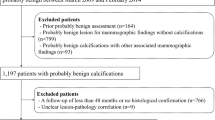Abstract
Background
Because of the increasing availability of screening mammography and spread of information about its benefits, the incidence of early breast cancer has been increasing in Japan. However, screening mammography can result in overdiagnoses or false positives, causing in some subjects undergoing unnecessary invasive procedures. The current mammography guidelines recommend further investigation of subjects with grouped amorphous calcifications; this recommendation may have resulted in overdiagnoses or false positives.
Methods
We retrospectively reviewed the charts of patients who had undergone screening mammography in the screening unit of our institution from January 2011 to December 2012 and been found to have grouped amorphous calcifications. Of the 233 such cases, 17 had been lost to follow-up, whereas whether the lesions were actually benign or malignant had been determined in the remaining 216 (92.7%).
Results
Six (2.8%) of 216 subjects with grouped amorphous calcifications were diagnosed as having malignancy and the remaining 210 (97.2%) as having benign lesions. Four of the six cases (1.9%) with malignancy had ductal carcinoma in situ and two (0.9%) 3 and 4 mm diameter invasive cancers of luminal type and nuclear grade 1.
Conclusions
Grouped amorphous calcifications identified on screening mammography contribute minimally to detection of breast cancer and are not thought to be associated with any identifiable improvement in prognosis; present recommendations concerning this finding may result in false positives and overdiagnoses.



Similar content being viewed by others
References
The Independent UK Panel on Breast Cancer Screening. The benefits and harms of breast cancer screening: an independent review. Lancet. 2012;380:1778–86.
Siu A, U.S. Preventive Services Task Force. Screening for breast cancer: U.S. preventive services task force recommendation statement. Ann Intern Med. 2016;164:279–96.
Japan Radiological Society/Japanese Society of Radiological Technology Edis. Mammography guideline [in Japanese]. Tokyo: Igaku Shoin; 2014.
Ohuchi N, editor. Japanese guidelines for quality assurance in mammography screening researchers on quality and efficacy improvement of breast cancer screening, Glant-in-aid for Cancer Research supported by the Ministry of Health, Labour and Welfare, Japan. 2005.
Bleyer A, Welch HG. Effect of three decades of screening mammography on breast-cancer incidence. N Engl J Med. 2012;367:1998–2005.
Welch HG, Black WC. Overdiagnosis in cancer. J Natl Cancer Inst. 2010;102:605–13.
Morimoto T, Kasahara Y, Tsunoda H, Tangoku A. Measures for reducing over-diagnosis in breast cancer screening [in Japanese]. J Jpn Assoc Breast Cancer Screen. 2014;23:337.
Nyström L, Rutqvist LE, Wall S, Lindgren A, Lindqvist M, Rydén S, et al. Breast cancer screening with mammography: overview of Swedish randomised trials. Lancet. 1993;341:973–8.
Nyström L, Andersson I, Bjurstam N, Frisell J, Nordenskjöld B, Rutqvist LE. Long-term effects of mammography screening: updated overview of the Swedish randomised trials. Lancet. 2002;359:909–19.
Miller AB, Baines CJ, To T, Wall C. Canadian National Breast Screening Study: 1. Breast cancer detection and death rates among women aged 40 to 49 years. Can Med Assoc J. 1992;147:1459–76.
Miller AB, Baines CJ, To T, Wall C. Canadian National Breast Screening Study: 2. Breast cancer detection and death rates among women aged 50 to 59 years. Can Med Assoc J. 1992;1477:1488.
Miller ABB, Wall C, Baines CJJ, Sun P, To T, Narod SA. Twenty five year follow-up for breast cancer incidence and mortality of the Canadian National Breast Screening Study: randomised screening trial. BMJ. 2014;348:g366.
Ryu EB, Chang JM, Seo M, Kim SA, Lim JH, Moon WK. Tumour volume doubling time of molecular breast cancer subtypes assessed by serial breast ultrasound. Eur Radiol. 2014;24:2227–35.
Terminology and Diagnostic Criteria Committee Japan Society of Ultrasonics in Medicine. Recall criteria for ultrasound breast cancer screening. J Med Ultrason. 2016;43:301–13.
Acknowledgements
We wish to thank Rina Kotake and Dr. Jay Starkey.
Author information
Authors and Affiliations
Corresponding author
Ethics declarations
Conflict of interest
There are no conflicts of interest to declare.
About this article
Cite this article
Iwase, M., Tsunoda, H., Nakayama, K. et al. Overcalling low-risk findings: grouped amorphous calcifications found at screening mammography associated with minimal cancer risk. Breast Cancer 24, 579–584 (2017). https://doi.org/10.1007/s12282-016-0742-z
Received:
Accepted:
Published:
Issue Date:
DOI: https://doi.org/10.1007/s12282-016-0742-z




